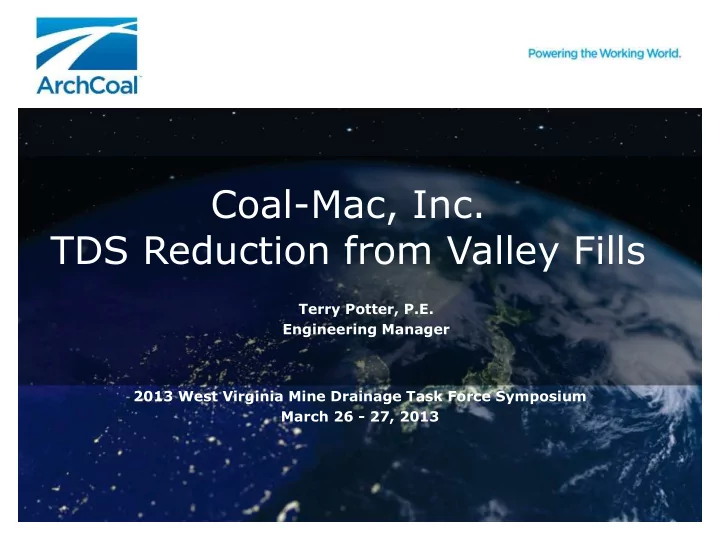

Coal-Mac, Inc. TDS Reduction from Valley Fills Terry Potter, P.E. Engineering Manager 2013 West Virginia Mine Drainage Task Force Symposium March 26 - 27, 2013
Coal Mac, Inc. • Subsidiary of Arch Coal, Inc. • Employees - 306 • Annual sales - 3 MM tons • Excavator/Loader mine VICINITY MAP PROJECT LOCATION Slide 2
Pine Creek 1 permit area • Valley fill 1 approved by USCOE, in conjunction with USEPA • Future fills contingent on Conductivity below Fill 1 remaining below 500 μ S/cm during construction • Stream Mitigation required Slide 3
Identify Source of TDS increase Pond et al. 2008 Pond et al. 2008 Un-mined Sites (7) Mined Sites (13) Mean SC: 62 μ S/cm Mean SC: 1023 μ S/cm Mean ion sum - 56 mg/L Mean ion sum - 1165 mg/L Sulfates contribute the greatest increase to TDS – from 16 mg/l to 700 mg/l Bicarbonates are next – from 21 mg/l to 186 mg/l Slide 4
Design and Construction techniques to reduce sulfates • Construct underdrain of durable, low-sulfur material to reduce sulfate reaction Material Type Sulfur content 100 – 500 ppm Sandstone 300 – 10,700 ppm Shale 400 – 60,600 ppm Fireclay 6,000 – 60,400 ppm Coal • Internal and surface drainage to prevent infiltration • Limited initial brushing (5 th bench level) Slide 5
Check dams and wrapped underdrain • Nine (9) check dams • Wrap 4,200’ of underdrain with filter fabric Slide 6
Fifth Bench Level Elev. - 1375’ • Compact and slope 5% to west side • 1,900’ underdrain daylights on 5 th bench Slide 7
Coalburg level - 1595’ 6,500’ pavement underdrain daylights into sediment ditch Slide 8
Valley Fill #1 and Backfill Configuration Slide 9
Slide 10
Dissolved Solids Composition at Sample Site BF1&2 Concentration – 195 mg/l Slide 11
How do results compare to fills without special BMPs? • Nearby Valley Fill 4 – Approx. 9 MM cu yds Slide 12
Dissolved Solids Composition below VF 4 Concentration – 1,229 mg/l BiCarbonates, 251, 20% Calcium, 143, 12% Manganese, 135, 11% Sulfates, 640, 52% Sodium, 32, 3% Potassium, 21, 2% Chlorides, 7, 0% Slide 13
TDS Comparison Slide 14
TDS Constituent Comparison - VF1 vs. VF4 Slide 15
Compensatory Mitigation • Stream Restoration – 3,800’ • Construct three (3) stream crossings • Install five (5) sand bio- filters Slide 16
Existing Gas well access road through stream Slide 17
Road construction and stream crossing Slide 18
Mitigated Stream – Left Fork of Pine Creek Slide 19
Benthic Locations • CMDLFPC – mouth of Left Fork • BF 1&2 – directly below Valley Fill 1 pond. Slide 20
Benthic Monitoring Sites Site CMDLFPC Site BF 1&2 TDS range 32 mg/l – 211 mg/l TDS range 244 mg/l – 587 mg/l WVSCI range 66.92 – 89.63 9.63 WVSCI range 55.95 – 83.10 Slide 21
Site BF 1&2 Graph of TDS vs. WVSCI TDS WVSCI 300 100 95 250 90 85 200 80 150 75 70 100 65 60 50 55 0 50 Winter 2011 Spring 2011 Summer 2011 Winter 2012 Spring 2012 Summer 2012 Winter 2013 Slide 22
Site WVDLFPC Graph of TDS vs. WVSCI TDS WVSCI 1000 100 95 900 90 800 85 700 80 600 75 500 70 400 65 300 60 200 55 100 50 Winter 2011 Spring 2011 Summer 2011 Winter 2012 Spring 2012 Summer 2012 Winter 2013 Slide 23
Summary • Conductivity has remained below required levels during construction of Fill 1 for past two (2) years. • Based on this success, US COE, in co-operation with US EPA, has authorized construction of second valley fill. • The work performed in this watershed has not resulted in a change in the WVSCI. No real correlation between Conductivity and WVSCI can be determined. Slide 24
Recommend
More recommend